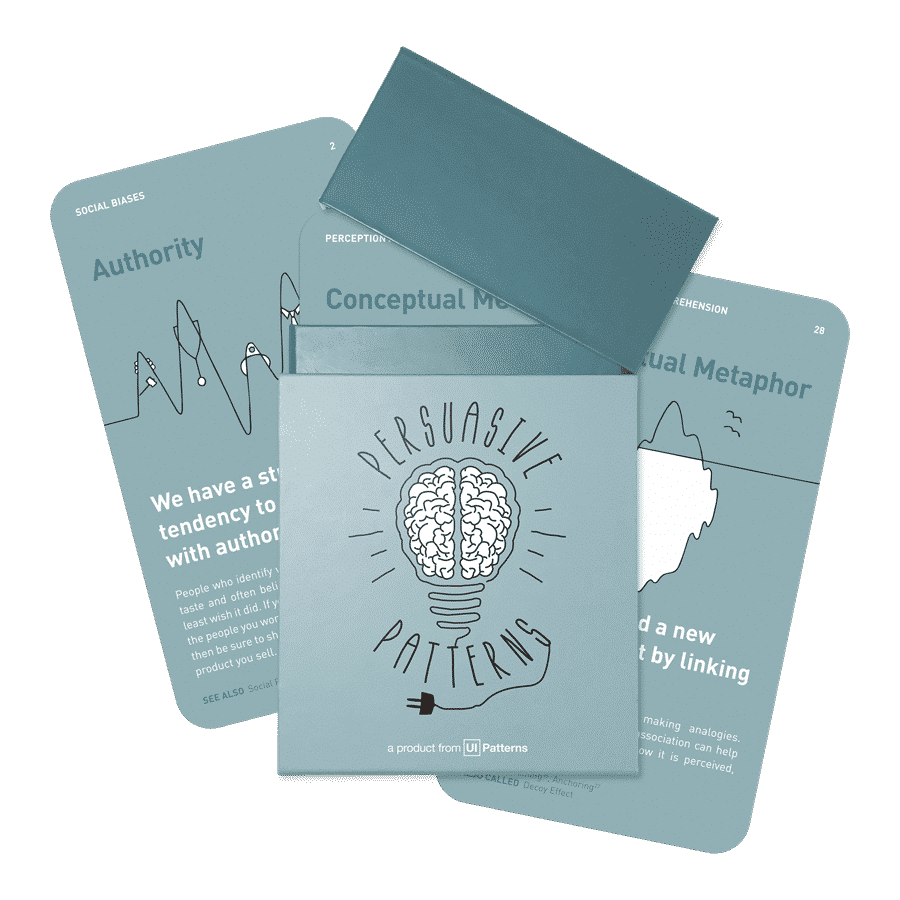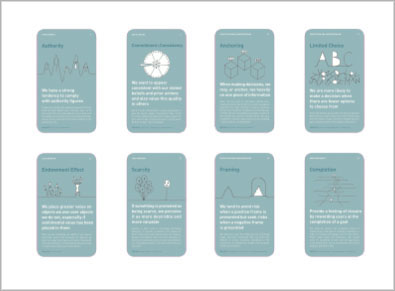Are persuasive design cards holding back your best ideas?
Why 'Patterns First' might be stifling your creativity - and what do to instead
Design for behavior change with the Persuasive Patterns card deck
Apply psychological principles to influence decisions, increase engagement, and optimize user experience.
Get your deck!If you’ve ever used persuasive design patterns to shape better user experiences, you already know their power. They help guide users toward action, tapping into proven psychological principles like scarcity, reciprocity, and commitment. But what if starting ideation with these patterns were actually limiting your creativity instead of enhancing it?
A recent study on the use of our persuasive pattern cards found something surprising: teams who began their ideation process with persuasive cards tended to generate similar, predictable ideas. In contrast, those who brainstormed freely first came up with a wider variety of solutions before refining them with behavioral insights. This effect, named as the Commonality Effect, reveals a hidden downside of relying too heavily on predefined design patterns. Instead of inspiring innovation, persuasive cards can sometimes lead teams down the same well-trodden paths, producing ideas that feel familiar rather than fresh.
“Teams who began their ideation process with persuasive cards tended to generate similar, predictable ideas. In contrast, those who brainstormed freely first came up with a wider variety of solutions before refining them with behavioral insights.
But why does this happen? Why do persuasive patterns, designed to stimulate creativity, sometimes end up stifling it? The answer lies in how our brains process structured information, and the very mechanisms that make design patterns effective might also be the ones that limit originality.
Why teams keep coming up with the same ideas
When a team sits down to generate ideas, their first instinct is often to look for structure; something to anchor their thinking. Persuasive design cards provide that structure, offering clear, predefined solutions. While this may seem helpful, it also introduces an unintended consequence: teams default to the patterns instead of thinking freely. Rather than exploring unique possibilities, they latch onto what’s already in front of them.
The study, Evaluating the Use of Persuasive Design Cards for Novice Designers, uncovered this effect through a series of workshops. Teams were split into two groups: one used persuasive cards from the start, while the other brainstormed without them. The results were striking. The groups that used cards immediately gravitated toward the same themes—socialization, personalization, progress tracking. Meanwhile, the teams that brainstormed first explored a much broader range of ideas, incorporating elements beyond standard persuasive tactics.

What’s more, many participants who used the cards reported feeling overly reliant on them. Some even discarded their own ideas in favor of those suggested by the cards, assuming the predefined solutions were more valid. This reliance on external input can create a subtle but significant problem: it limits the brain’s natural ability to generate original ideas before refinement begins. And that’s not the only issue.
The study also found that first-round ideas, whether using cards or not, were often predictable and surface-level. The most interesting concepts only emerged in later brainstorming rounds, once teams pushed past the obvious.
The problem arises from applying a framework to start up ideation, rather than starting off with raw unfiltered thinking.
So does that mean that Persuaisve Patterns doesn’t have a place? Not at all. The problem isn’t the cards themselves, it’s how we use them. The good news is there’s a simple fix that allows teams to retain the benefits of persuasive patterns without falling into the Commonality Effect trap.
The “Ideas First, Patterns Later” Method
Instead of letting persuasive patterns lead the way, the smarter approach is to flip the process. Start with raw creativity, then refine it with behavioral insights. The exercise called Ideas First, Patterns Later, targets this problem straight on - helping teams unlock original thinking before applying structured frameworks.
The first step is to begin ideation without any patterns or predefined structures. Gather your team and lay out the problem you’re trying to solve. Resist the urge to categorize or structure ideas too soon. Instead, focus on free association and wild thinking. The goal is to explore as many possibilities as possible before introducing constraints.
The goal is to explore as many possibilities as possible before introducing constraints.
It is respecting the divergent phase of ideation - and not prematurely starting the convergent phase, closing it down too soon with constraints.
Once you have a strong pool of ideas, only then should you bring in persuasive design patterns. At this stage, the cards become a tool for enhancement, not initiation. Instead of dictating the direction of ideas, they help sharpen, strengthen, and optimize what’s already there. This shift prevents teams from falling into pattern-matching mode too early and allows for genuine innovation before refinement.
Another interesting tweak could be to discard the first round of ideas altogether. Research suggests that first-round brainstorming tends to produce the most obvious, predictable solutions. It’s the second and third rounds where deeper creativity kicks in. By forcing yourself to push past initial thinking, you increase the chances of discovering something truly unique.
If you really want to break free from conventional thinking, introduce an element of randomness. Pick two unexpected persuasive pattern cards and force yourself to combine them into a single idea. This technique challenges habitual thinking and forces teams to stretch their creativity, often leading to surprising and effective solutions.
Unlocking a new level of creativity
By shifting from a Patterns-First to an Ideas-First approach, teams gain the best of both worlds. They get the benefits of unconstrained, original thinking, while still using proven behavioral tactics to refine and optimize their solutions. The result? More diverse, creative, and impactful ideas that don’t just follow the same predictable patterns.
If you’ve ever left a brainstorming session feeling like you didn’t break new ground, this could be why. The very tools meant to inspire innovation might actually be limiting it—unless you use them strategically. So the next time you sit down to design a new experience, resist the urge to reach for persuasive patterns right away. Give your team the space to explore freely first. You might be surprised by what you discover.
- Alkhuzai, K., & Denisova, A. (2021). Evaluating the use of persuasive design cards for novice designers. Journal of Usability Studies, 16(2), 91–120.
- Paulus, P. B., & Brown, V. R. (2007). Toward more creative and innovative group idea generation: A cognitive-social-motivational perspective. Social and Personality Psychology Compass, 1(1), 248-265.
- Osborn, A. F. (1953). Applied imagination: Principles and procedures of creative thinking. Charles Scribner’s Sons.
- Paulus, P. B., & Brown, V. R. (2007). Toward more creative and innovative group idea generation: A cognitive-social-motivational perspective. Social and Personality Psychology Compass, 1(1), 248-265.
- Finke, R. A., Ward, T. B., & Smith, S. M. (1992). Creative cognition: Theory, research, and applications. MIT Press.

